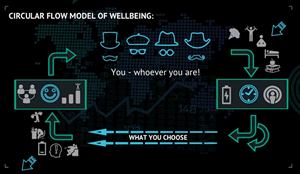 “The Circular Flow Model of Wellbeing (CFMW) holds that one has certain factors (time, attention and energy) of production, which are deployed by humans for certain activities, which will return an outcome (feeling good, being connected or doing well). And, that one promotes flourishing by maximising the return on investment of one’s factors.”
“The Circular Flow Model of Wellbeing (CFMW) holds that one has certain factors (time, attention and energy) of production, which are deployed by humans for certain activities, which will return an outcome (feeling good, being connected or doing well). And, that one promotes flourishing by maximising the return on investment of one’s factors.”
One could say, that the study of flourishing has ‘flourished’ in the past decade and a half, as key scholars have provided important insights into understanding our own potential. Indeed, I believe that the work has been so extremely compelling, that the case for schools to engage with this body of knowledge is nigh incontestable. Hence, I am now more committed then ever, to the notion that the institutions that can unlock this potential will be those that thrive best in the decades to come. Unfortunately, until now, it has often been difficult for schools to draw together the knowledge base and capture the insights that would allow for successful strategy implementation and sustainable evolutionary development in this area.
To close this gap, I am seeking forward-thinking schools to collaborate on the development of a new framework for human flourishing, drawing together key ideas in positive psychology as they relate to schools, for schools. To borrow a Newtonian phrase, we will ‘stand on the shoulders of giants’ and move positive education forward from possibility to probability.
The Circular Flow Model of Wellbeing is an eloquently simple model that is based very loosely on a well-known Economic model. In summary, the model aims to raise awareness of our human resources; the only resources we have to affect change in our world; our time, our attention and our energy. With these resources, we make decisions about how they shall be invested in various areas of our lives; here we must choose with meaning and purpose. It follows then, that the investments of our time, attention and energy will inevitably deliver us a return. The return is, feelings of positive emotion, being connected (relationships) and/or making progress (accomplishment or mastery).
Investments of time, attention and energy
=
returns in positive emotion, being connected and doing well
Viewed this way, it becomes clear that there are three worthwhile ways to improve flourishing:
- Increase time, attention and/or energy;
- Make wise investments when choosing what to spend time, attention and energy on;
- Stop any leakages of time, attention and/or energy.
Empowering students to understand their roles in promoting flourishing and personal growth is, in my humble opinion, the highest educational aspiration, and one I hope you will consider joining me in.
The current research project is planned in three phases.
| Phase | Description | Complete |
| 1 | Develop the theoretical framework based on extensive review of the literature. |
P (2016) |
| 2 | Development and psychometric validation of an accompanying survey instrument to provide quantitative indicators to measure students’ relationship with time, attention and energy, and their subsequent feelings of positive emotion, being connected, and making progress. |
(2017) |
| 3 | Longitudinal qualitative studies and release of a ‘flourishing curriculum road map’ to coach students to increase time, attention and energy, choose meaningful goals and actions, which will promote flourishing and to limit leakage from their circular flow. |
(2018) |
The vision is that schools all over the world will use this model to frame their flourishing strategy and hence, schools involved in phase three of the project will position themselves uniquely at the forefront of positive education.
The project is part of a doctoral study conducted via UCL (University College London – Institute of Education), and has the full ethical approval and backing of the institution.
I am currently seeking participant schools for Phase 2 of the project. Phase 2 requires two 40-minute survey response sessions from students aged 16 years or older. Through this, data will be triangulated against the PERMA Profiler and the Satisfaction with Life inventory. Using this data, we will be able to (a) test the psychometrics of the Circular Flow survey and (b) give your school a report about where you are doing well, a comparison to like schools and suggestions for improving flourishing.
Following completion of Phase 2, and receipt of your individual school report, schools may choose if they wish to be part of Phase 3. In this case, schools will be fully supported with curriculum materials and implementation planning, as well as staff training to run onsite pilots of the flourishing school framework with their students.
If you wish to take up this unique opportunity, or for further information, please do not hesitate to make contact using the e-mail address below.
Jeremy G House
j.house at stgis.at


